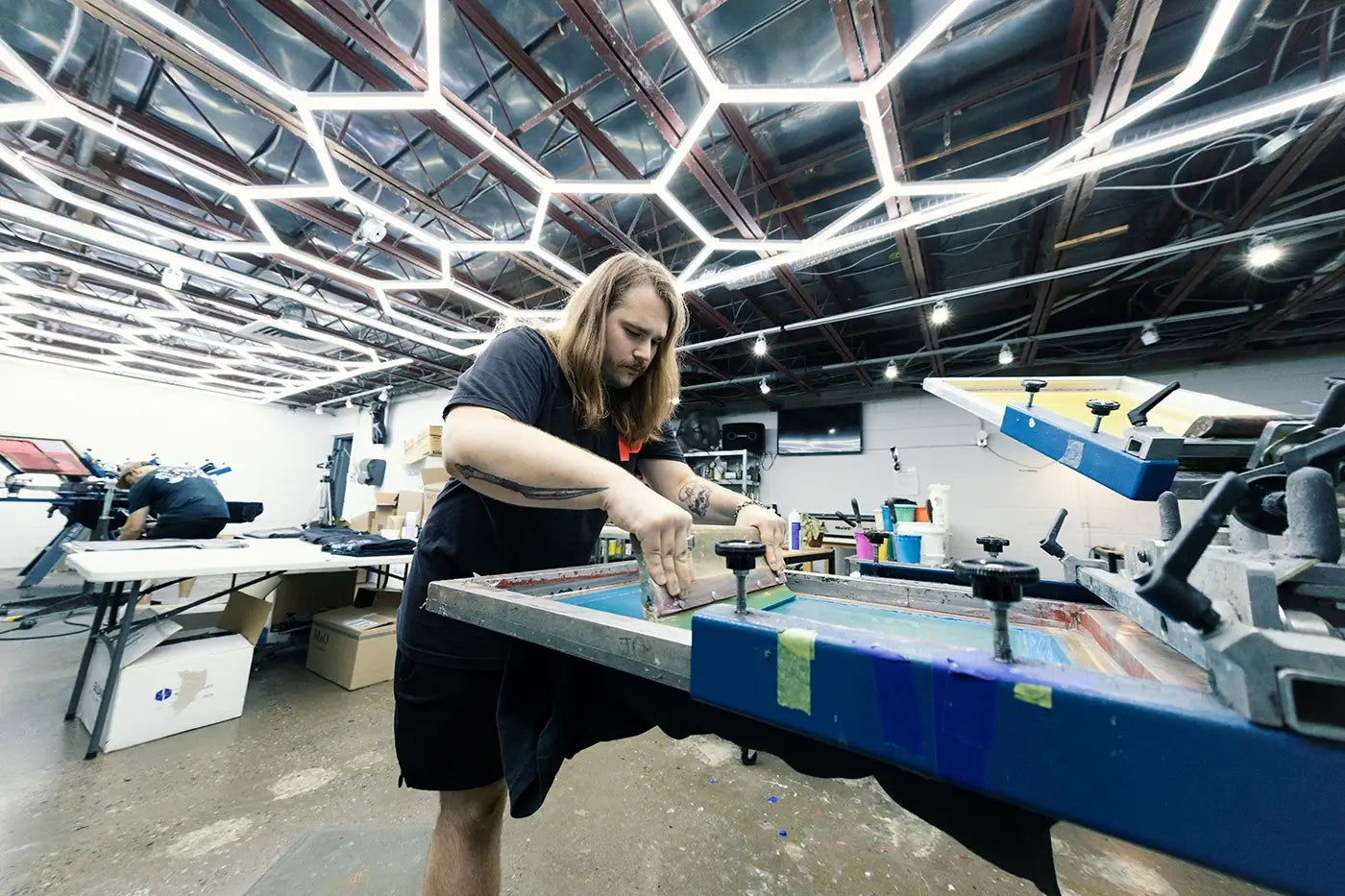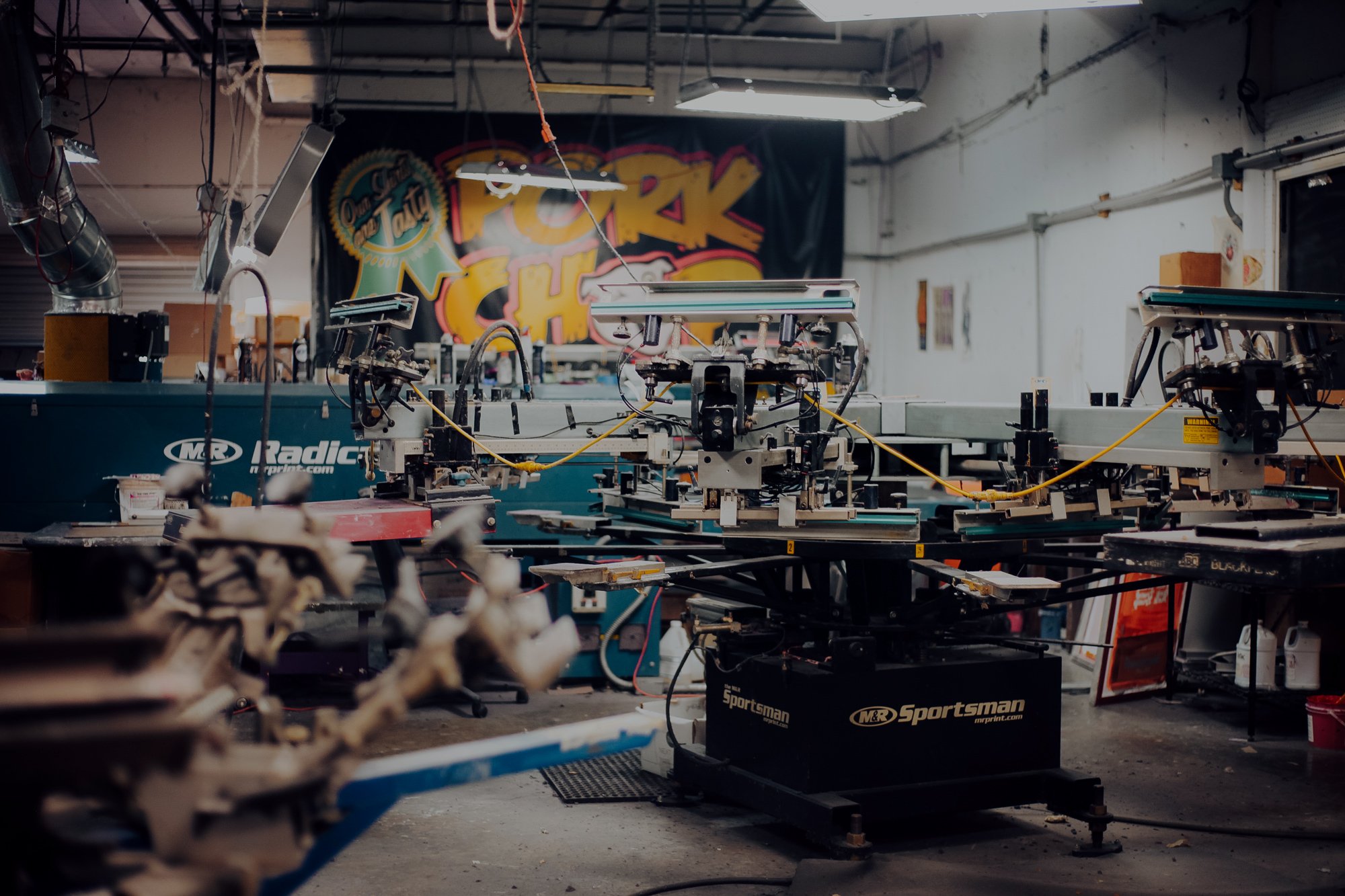Budget-Friendly T-Shirt Printing for Startups
Budget-Friendly T-Shirt Printing for Startups
Blog Article
Display Printing Uncovered: Everything You Need to Know Concerning T-Shirt and Garment Printing Methods
Screen printing is a fascinating approach that integrates art with technique, providing countless opportunities for imagination. Ready to explore the vital components that make display printing an art form?
The Fundamentals of Display Printing: How It Functions
When you dive right into screen printing, you'll discover it's both a science and an art. At its core, screen printing entails developing a stencil, or display, that enables ink to travel through just in certain areas (screen printing kit). You begin by selecting your layout and preparing your screen with a light-sensitive solution. When you expose this solution to light, it hardens, leaving your layout as an unfavorable area.
Placement the screen over the material, after that use a squeegee to push ink via the display onto the garment. Each action is vital, and mastering them will elevate your screen printing skills, transforming basic garments right into special, expressive pieces.
Kinds of Screen Printing Techniques
Once you realize the fundamentals of display printing, it's time to discover the various methods that can boost your styles. One popular technique is typical screen printing, where ink is pushed via a stenciled display. This strategy is terrific for vibrant, dynamic colors. There's water-based ink printing, which provides a softer feel and is eco-friendly, but it needs a different method to curing.
An additional alternative is plastisol printing, known for its toughness and brilliant colors, making it a favored for numerous brand names. Experiment with halftone printing to develop gradient impacts and intricate layouts.
Crucial Tools for Screen Printing
To attain spectacular cause screen printing, having the appropriate equipment is basic. Initially, you'll need a strong display printing frame, which holds the mesh that transfers your layout onto the garment. Next, buy premium squeegees; these are necessary for using ink evenly across the display. You'll also need an excellent exposure unit to produce your displays, along with a washout booth for cleaning them after usage. A trusted heat source, like a conveyor dryer or warm press, is critical for curing your prints to ensure durability. Do not fail to remember a correct office, furnished with tables and storage for your materials. Ultimately, protective equipment, such as masks and handwear covers, will keep you secure from chemicals and inks. With the right tools, you'll be well on your way to generating professional-quality prints.
Selecting the Right Inks and Materials
When choosing inks and products for screen printing, you require to take into consideration the sort of ink that works finest for your job. Think of material compatibility to ensure your designs look excellent and last long. Discover environment-friendly ink choices to make your printing procedure much more lasting.
Kinds Of Display Inks
Picking the ideal screen ink is important for accomplishing vivid, sturdy prints that fulfill your job's demands. There are numerous kinds of screen inks to examine. Specialized inks, such as glow-in-the-dark or metal, can include special effects to your styles.

Fabric Compatibility Considerations
Recognizing textile compatibility is important for attaining top quality display prints, particularly since various materials respond uniquely to different inks. Constantly check your inks on sample material to assure they stick effectively and preserve shade integrity. Furthermore, maintain in mind that fabric weight and structure can impact the last end result, so choosing the right ink and material combination is essential for your project's success.
Eco-Friendly Ink Options
Green inks are becoming a prominent selection for display printers that desire to minimize their environmental effect while keeping high quality. When picking inks, consider water-based inks, which are less dangerous and simpler to cleanse up contrasted to conventional solvents. These inks bond well with materials, providing lively outcomes without toxic chemicals. You might likewise check out eco-solvent inks that make use of fewer volatile organic compounds (VOCs), making them a much safer alternative for both your wellness and the planet.
Furthermore, seek inks made from sustainable resources, such as soy or vegetable-based choices. By choosing the right over at this website inks and materials, you'll not only create spectacular designs but also add to an extra lasting printing procedure. Make the switch, and your prints will mirror your dedication to the setting!
Preparing Your Layout for Display Printing

File Format Needs
To assure your layout looks dynamic and sharp on material, you'll require to pay close focus to submit layout needs for screen printing. Make sure your design has a transparent background to prevent unwanted white sides on your prints. Keep color modes in mind; CMYK is conventional for screen printing, so transform your RGB develops accordingly.
Shade Separation Methods
Shade separation is an important action in preparing your design for screen printing, and understanding it can considerably enhance your print top quality. You'll need to damage your style right into private shades, as each color requires a different display during printing. This accuracy not only ensures accurate shade representation however additionally improves the printing process.
Resolution and Dimension
Accomplishing the ideal outcomes in display printing begins with assuring your style has the right resolution and dimension. Ideally, your artwork needs to be at least 300 DPI (dots per inch) for sharp, clear prints. If you use reduced resolution, your end product may look pixelated and amateur.
When it involves dimension, take into consideration the dimensions of your print location. Design your art work to match the final print size, preferably producing it in the actual measurements you'll be publishing. This method, you'll stay clear of any unanticipated scaling problems.
Constantly check your design in both vector and raster layouts. Vector graphics can be scaled without losing top quality, making them excellent for screen printing. Preparing properly will ensure your layout looks impressive on every garment!
Step-by-Step Screen Printing Process
Display printing is a dynamic process that allows you to create dynamic layouts on different surface areas. To start, you'll require a screen, emulsion, and your picked ink. Prepare your display by cleansing it thoroughly. Next, apply the emulsion uniformly and let it dry in a dark area. Once dry, reveal your screen to light with your style put on it, which will solidify the solution where the light hits, creating a stencil - screen printing kit.
After washing out the unexposed solution, your display is prepared. Establish it up on your printing surface and align your garment under it. Pour visit site ink onto the screen and make use of a squeegee to press the ink via the pattern onto the material. Raise the display meticulously and let the print dry. Heal the ink making use of heat to assure longevity. That's it! You've effectively display published your design.
Tips for Successful Display Printing Projects
While you're discover this diving into your screen printing jobs, keep in mind that prep work is key to success. Start by gathering all your materials-- inks, garments, mops, and screens. A tidy workspace aids protect against undesirable errors, so clean before you start.
Next, verify your artwork is high-resolution and correctly sized for your garment. Examine your display for correct exposure and tidy it thoroughly to avoid spots. When blending your inks, follow the supplier's standards to achieve the best consistency.
During printing, use even pressure with your squeegee for consistent results. Don't rush; take your time to verify each print meets your criteria. After printing, let your garments completely dry totally prior to handling or packaging them.
Last but not least, constantly keep an example of your work for future reference. By doing this, you can examine your development and boost your strategies gradually. Happy printing!

Frequently Asked Inquiries
For how long Does It Require To Establish a Screen Printing Work?
Establishing a display printing job typically takes around thirty minutes to an hour. You'll prepare the displays, mix inks, and adjust the press. The moment varies based on complexity and experience, so stay arranged!
Can I Publish on Various Material Keys In Using the Exact Same Method?
Yes, you can publish on different fabric kinds using the exact same method, yet you'll need to adjust your settings and inks. Some materials take in ink in a different way, so trying out guarantees the finest outcomes for each material.
What Prevail Errors to Stay Clear Of in Screen Printing?
When screen printing, prevent typical errors like using the incorrect ink, disregarding proper exposure times, or skipping pre-press checks. Constantly check your arrangement and preserve clean screens to guarantee high quality results each time.
How Can I Appropriately Clean and Maintain My Display Printing Tools?
To correctly clean and maintain your display printing equipment, you must frequently clean displays with suitable solvents, examine mops for wear, and assure all devices are saved dust-free and dry. Uniformity improves and avoids pricey repair services efficiency.
Is Screen Printing Eco Pleasant Contrasted to Other Techniques?
Screen printing can be extra eco-friendly than various other methods, particularly if you use water-based inks and eco-conscious products. By choosing sustainable supplies and techniques, you lower waste and decrease your influence on the planet.
Screen Printing Uncovered: Everything You Need to Know Concerning Tee and Garment Printing Techniques
At its core, display printing entails producing a pattern, or screen, that permits ink to pass via just in particular areas. Position the screen over the textile, then utilize a squeegee to press ink with the screen onto the garment. One prominent method is typical display printing, where ink is pressed through a stenciled screen.When selecting inks and materials for display printing, you require to take into account the kind of ink that functions ideal for your task.
Report this page